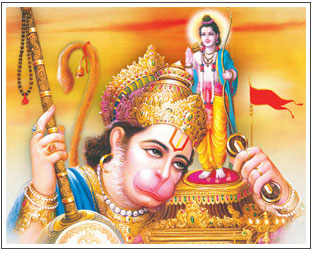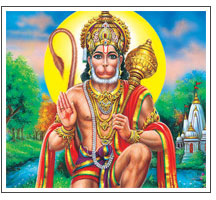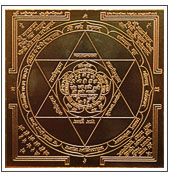Hanuman or the monkey god lived in another epoch/yuga during the ages of Lord Rama. In Vedic philosophy, he is considered to be the ultimate devotee of Sri Rama. He depicts strength, bravery, courage, wisdom, and the ability to fly. Hanuman can accomplish all acts that human beings cannot.
According to the Vaishnava traditions, Hanuman is not a god but a human who evolved to God’s level. He represents the qualities of omniscience, omnipotence, and omnipresence. Understanding of the archetype, Hanuman is crucial for all those who are preparing for The Golden Age.

Hanuman is not confined only to India; stories and folktales about him exist in Sri Lanka, Thailand, and Indonesia.
Known also as Anjaneya, Maruti, Pavanputra, Anjaniputra, Ramdhoot, Bajrang Bali, and Hanumat, Hanuman’s exploits are celebrated in a variety of religious and cultural traditions.
Most Southeast Asia cultures are rooted in Indian influences, which filtered through the region from around the second century AD onwards. Religious, mythological, linguistic, and other elements of Indian culture were absorbed and thus became especially persuasive. Various local populations adapted and molded Indian influences to their ways, gradually evolving distinct cultures yet with common roots.
Most influential of all was the Ramayana, which, along with the Mahabharata, ranks as India’s greatest literary work. They both are the most important and popular epics of India.
The book of Ramakien is the Thai version of the Indian Ramayana epic. The epic goes that Rama, Vishnu’s reincarnation on earth and heir to the throne of Ayodhya in Northern India, is banished from heaven and spends fourteen years in exile on earth with his wife Sita and his brother Lakshman. With the assistance of a monkey army whose commander is Hanuman, the monkey god, they set out to destroy evil forces on earth.
Since 1902 the Ramakien has become part of Thailand’s school curriculum. This epic literature contains romance, adventure, heroism, magic, demons, and gods. Here are just some of the characters who have martial connections:
There are many Muay Thai techniques, which are inspired by stories, for example:
All these are even depicted in Muay Thai (Thai Boxing) as various techniques. Thus, the archetype of Hanuman has been a major part of the cultural history and traditions of not only India, where it was born, but also in major countries of South-east Asia.

Hanuman, the son of Vayu (Wind God), is known for his humility and bravery. Due to his supernatural powers, everything becomes possible for him.
Hanuman is a favorite character all over South East Asia, and his most celebrated quality is his total devotion to his master, Rama. It thus stands as the most important lesson in the Indian philosophy:- ‘absolute surrender is the secret to reach the Almighty.’ He plays a vital part in the epic, Ramayana
It is customary to call out to Hanuman at all times of need, and the devotee is confident that his prayer will be answered. On Saturdays and Thursdays many people observe fast in honor of Hanuman and dedicate special offerings to him. Hanuman is believed to work miracles even today.
Hanuman is the only God not affected by the ill effects of planet Saturn. He, therefore, is the symbolic God to protect oneself from the ill-effects of Saturn. Devotees of Hanuman are blessed with courage and wisdom.
One of the lucky charms the former US President Barack Obama carried during his presidential election campaign, was a small idol of the monkey God Hanuman. He became familiar with Hanuman during his stay in Indonesia, where Hinduism is popular.
Carolyn Sauvage-Mar, Obama’s representative, received a gold-plated two-feet-high Hanuman in New Delhi, India’s capital. It was presented by a group of well-wishers to help Obama to emerge victoriously!
In Ramayana, Hanuman is said to have rescued Saturn (Shani Bhagavan) from Ravana’s clutches. In gratitude, Saturn (Shani Bhagavan) promised Hanuman that those who prayed to him (Hanuman) would be spared from the negative effects of Saturn, which in Hindu astrology is said to produce malefic effects on one’s life when one is affected “negatively” with Saturn.

Another version of the encounter between Hanuman and Saturn (Shani Bhagavan ) is that the latter once climbed on to Hanuman’s shoulder, implying that he (Hanuman) was coming under the effects of the influence of Saturn (Shani Bhagavan). At this, Hanuman assumed a large size, and Shani was caught painfully between Hanuman’s shoulders and the ceiling of the room they were in. As the pain was unbearable, Shani requested Hanuman to release him, promising that if a person prayed to Hanuman, he (Shani) would moderate the malefic effects of his influence on that person; following this, Hanuman released Shani.
Here is one more version of the story behind why Lord Shani stays away from those who remember Rama’s name. Once Lord Hanuman was sitting silently absorbed in deep meditation of Rama. Lord Shani passed by and began to tease Hanuman. He started teasing Hanuman by pulling his tail and pinching.
Hanuman warned him to go away as he is his Guru’s (Lord Sun) son, and so he respects him. When Shani did not pay heed, Hanuman got into a martial combat with Shani Bhagavan. In the end, Shani pleaded to leave him and Hanuman took a promise from him that Shani will never go near a devotee who is meditating on Rama.
There is a spiritual interpretation of the relation between Hanuman and Lord Shani. The former is a symbol of selflessness, while the latter is symbolic of instant judgment based on past and present karma. Thus, to counter the karma borne out of selfish action, one must be humble like Hanuman. This is particularly true for those who are said to be experiencing the evil effects of “Sade Sati” – a period of about seven and half years when Saturn (Lord Shani) is supposed to afflict the sign in which planet Moon is placed in the natal chart of a person.
There is also a belief that all the planets are under the control of Hanuman’s tail. Whoever worships Hanuman is granted fortitude and strength. He is considered to be the lord of Mars. Mars is considered to be the Senapati (General) of the God’s army. In the human body, Mars symbolizes blood.
This monkey god represents full service to humanity. He represents the possibility of human evolution from a life of pain, suffering, fear, and ignorance to intelligence, courage, and knowledge. Helping humans evolve and emulate qualities of the divine, Hanuman, in the year 2020, brings hope to humanity. He represents the ability of humanity to achieve unlimited power, intelligence, and energy to do everything.
According to the Madhava tradition, (Madhava himself is an incarnation of Hanuman), human beings cannot become god- but can rise up to this level of Hanuman.
Dedicate this year to connect with Hanuman’s archetype for transcendence, strength, power, and a life free from ignorance. Meditating on hanuman brings you positive energy and acts as a protection ring.
Chant the Mantra (Quantum Sound Frequency )given by Dr. Pillai to invoke Hanuman’s blessings and grace in your life. OM REENG HREEM MARKATA MARKATAYA SWAHA Get a Shiva-Shakti mala, made from rudraksha/crystal beads, and chant these quantum sound frequencies 108 times daily.

Yantras, (Archetypal symbols) are empowered diagrams with squares, triangles, circles in a certain permutation and combination, made in sacred geometry and perfect symmetry. These symbols were used to attract one’s desires and wants. Every archetypal symbol is empowered by its Archetypal being. The Archetypal Symbol is the conduit through which you connect with the Archetypal Being. These empowered diagrams were cognized by the yogic seers in deep states of Samadhi (Mind Process).?
Hanuman, the Guardian deity, will guard you against all dangers and strengthen you with courage and knowledge. His unflinching energy will power up your lifeline and stimulate your inner spirits. Hanuman Yantra contains the power lines that could attract his blessings towards you; the positive radiations will relieve you from incurable illnesses, laziness and bless you with longevity, courage, productivity, and effective communication skills.
Mantra for Hanuman Yantra (Archetypal Symbol) :
Om Anjaneyaya Vidmahe
Vayuputraya Dheemahi,
Tanno Hanuman Prachodayat
Note: The specified Mantra is to be recited 108 times as a standard rule; however, changes, if any, will be mentioned at the time of buying.